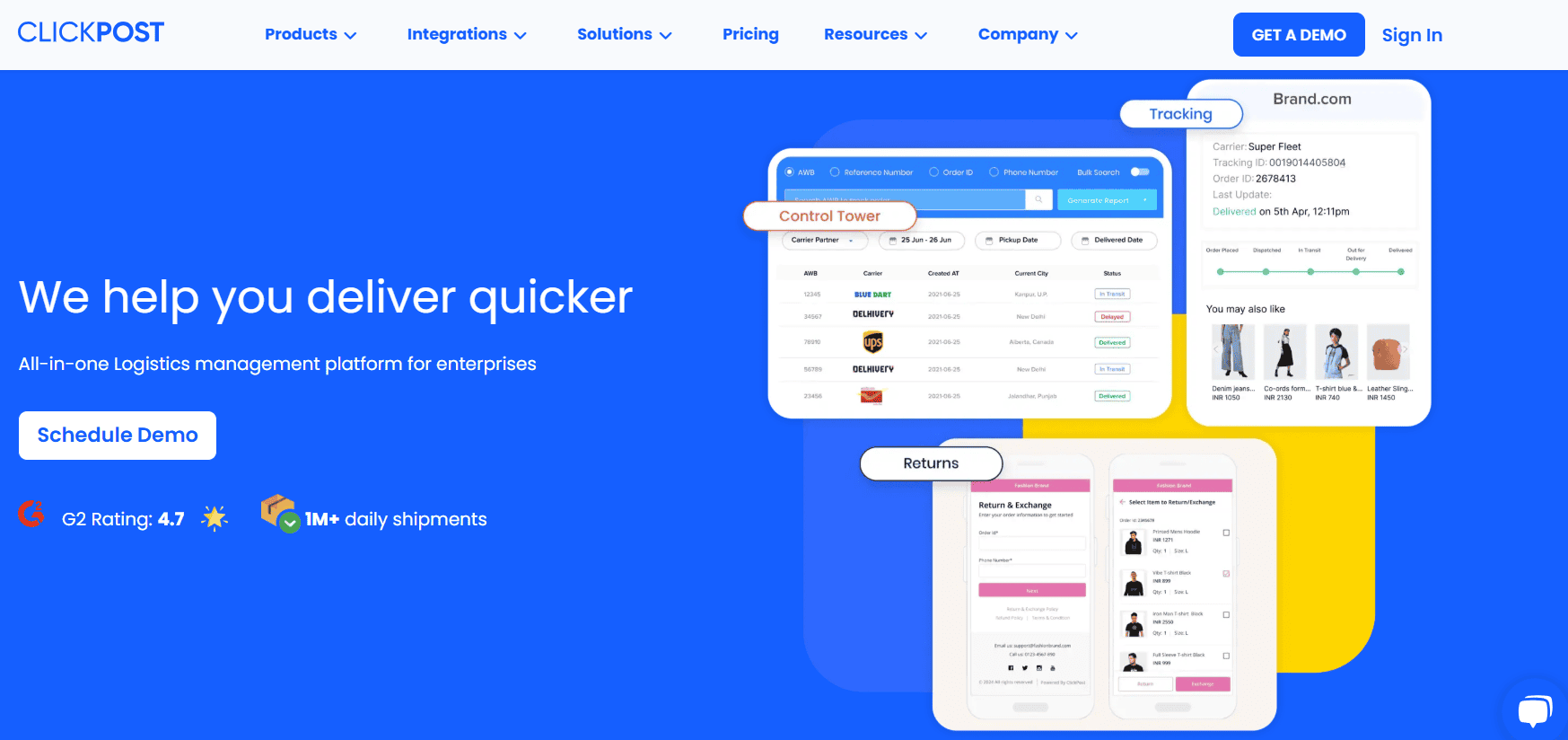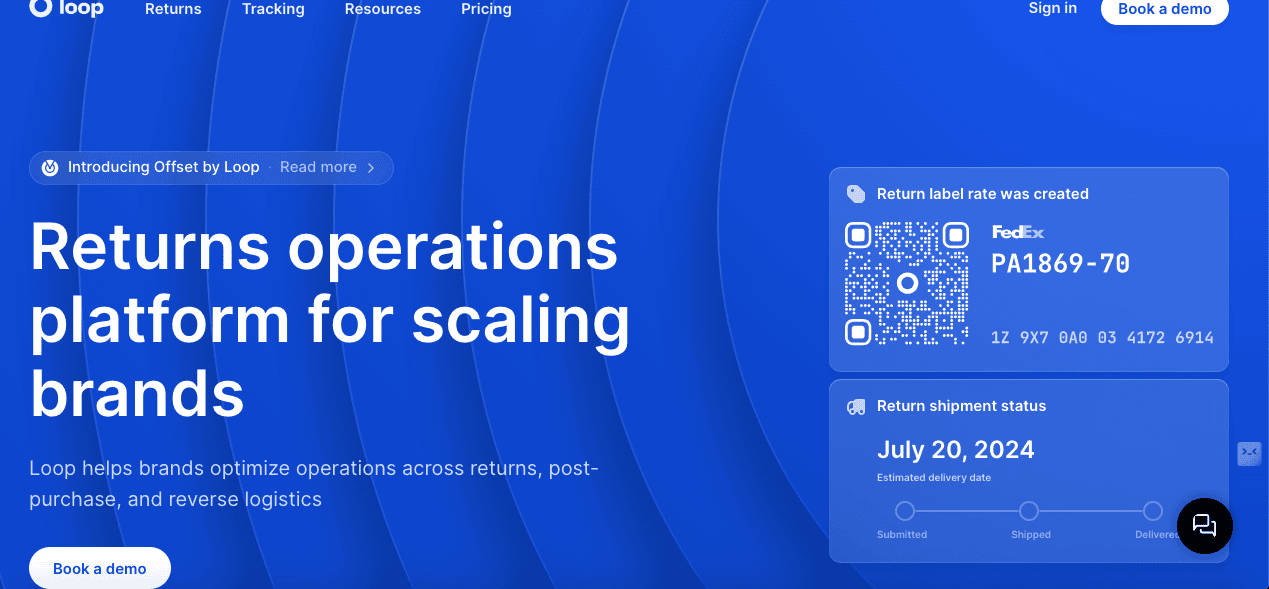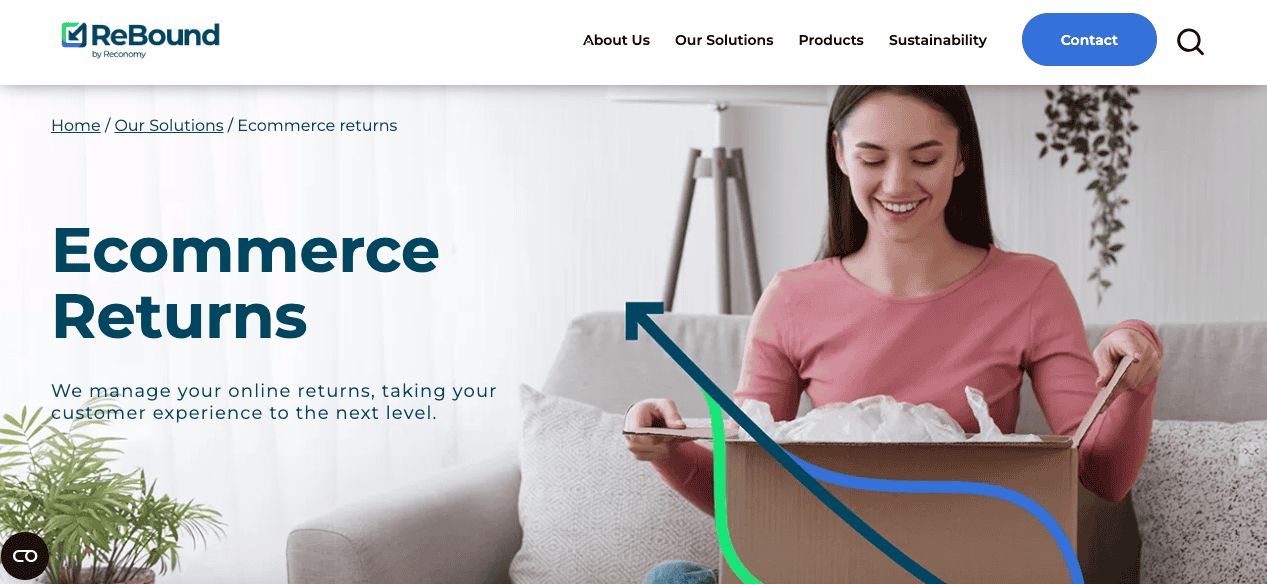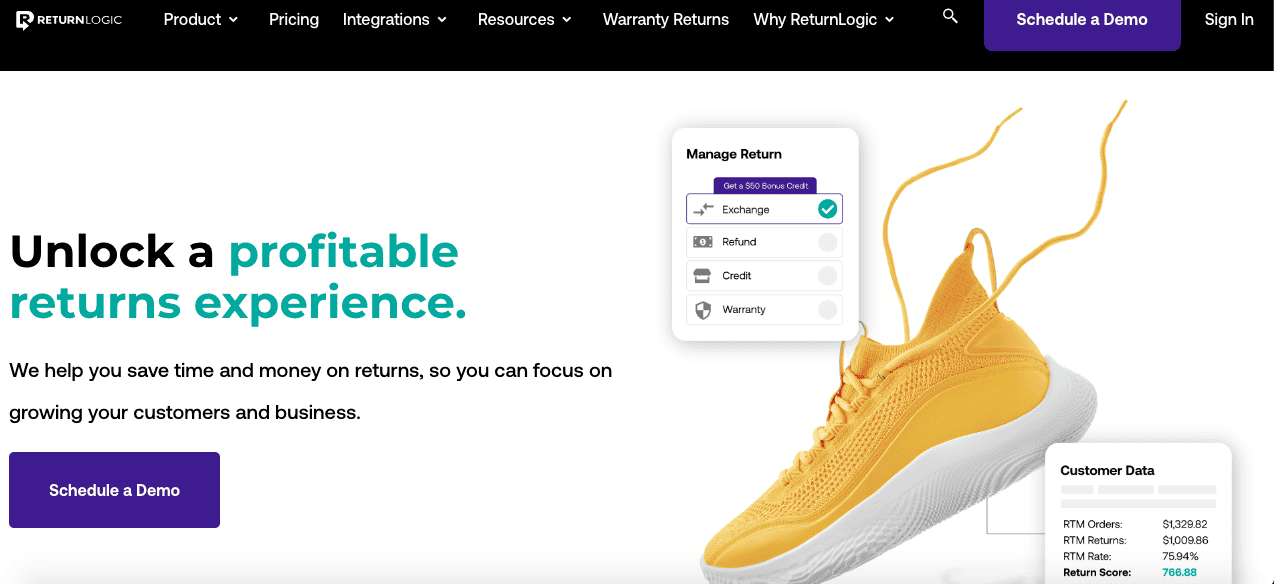With the rise of online shopping, a significant increase in consumer returns has also emerged. This unfortunate negative impact of eCommerce returns presents many challenges for modern businesses.
Thus, you must focus on efficiently handling and processing customer returns to reduce inventory losses.
According to Shopify, the average return rate for online stores was 17.6% in 2023. The reasons for these returns are predictable, including sizing issues, damaged goods, delivery problems, failure to set customer expectations, products no longer wanted, fraudulent returns, and so on.
Now that we know the problem, we need to find the solution. Once you gain complete control over your eCommerce returns, you can save costs, maintain profit margins, increase customer satisfaction, and enhance brand loyalty.
In this blog, we will discuss how to manage and reduce your eCommerce returns, execute the best practices to ace this process, and turn the returns into lucrative opportunities for your business.
So, without further ado, let’s dive in!
Table of Contents
Key Takeaways
- The key to managing eCommerce returns is creating a clear and comprehensive return policy that must include the time frame, refund method, and product condition to qualify for the return.
- Keep your customers informed about their returns’ status by giving them real-time visibility into returns operations and automating the whole process from receiving the return request to approving it.
- Automate the return process by leveraging the power of the best eCommerce return tools, including Loop Returns, ReBound, ReturnLogic, and Aftership.
- Reverse logistics are integral in processing, tracking, and transporting the goods back to the sender, storing them in a warehouse, and handling disposal options.
- Use high-quality product descriptions, user-generated photos, and your customer reviews to reduce the rate of returns by setting the right expectations for your customers.
Understanding eCommerce Returns
eCommerce return is the reverse logistics process in which products are returned to the sender. These returns are part and parcel of eCommerce business; there could be various reasons for them, such as incorrect sizing, customers changing their minds, product defects, etc.
The buyer initiates the return process, which the seller processes (as per the return policies). Once the seller processes it, the buyer must return the product. The seller initiates the refund only if it is returned in its original condition within the outer box or case, depending on the product.
Being a seller, you might think it is better not to offer return policies. However, with well-drafted and positioned return policies, you can gain access and establish a border market reach. Many customers may hesitate to purchase, impacting your sales and revenue.
Thus, leveraging returns is essential to nurturing customer relationships, reducing churn rates, encouraging repeat business, and driving business growth.
Having said that, developing a well-structured return policy will contribute to increased customer satisfaction, profitability, and brand credibility.
Read also: How to Write Effective Order Cancellation Emails
Developing a Robust eCommerce Returns Policy
Create customer-friendly return policies while ensuring they are clear and concise. It should state who pays for return shipping, the condition of the product, the return timeframe, and the refund method.
Let’s understand all these necessary elements to develop a strategic return policy.
1. Clear and comprehensive refund eligibility
One of the most important things to ensure while developing eCommerce returns policies is that they should be transparent and brief. Your return policies must be easy for your customers to understand.
This helps build brand loyalty and even encourages purchases.
2. Time frame for refund requests
What is the time frame for initiating a refund for the products you receive back from your customers? It would help to mention this refund time frame when you frame your return policies.
Listing the reasonable refund time frame ensures that your customers know the deadline and can take subsequent action if they want to return the product for any reason.
3. Condition of returned items
A well-detailed eCommerce return policy always mentions whether customers can return an item. Companies should always inform their customers how and when to return products and in what condition.
Most companies accept returns of goods that are unused and in original condition, which should be mentioned in your policy. You must also clearly state any exceptions, such as personalized products or final sale items.
4. Proof of purchase
A proof of purchase is a document or receipt that confirms the purchase of a product or service. This document can be an order confirmation mail, delivery message, or packing slip.
It helps verify the buyer’s legitimacy and entitles them to a refund.
5. Handling of return shipping costs
Detailed returns always include whether the seller or buyer is responsible for bearing return shipping costs. Some businesses offer free returns; however, some charge for them.
Thus, you must ensure that your policy clearly states the return shipping cost to avoid any dissatisfaction or confusion among your customers.
6. Contact information for refund inquiries
Ensure you mention your company’s contact information, such as phone number, email ID, or a link to the customer service portal that handles refund-related queries.
Providing this information to your customers helps them quickly contact you for any assistance.
7. Policy updates and change
Include a statement reserving the right to change or update the refund policy. Also, specify how customers will be notified of these updates, such as on the customer’s email or the company’s website, to keep your customers informed of policy amendments.
8. Non-refundable items
Remember to list non-refundable items in your policy, such as perishable goods, gift cards, digital downloads, etc. Clearly outlining these exceptions makes the entire process transparent and enhances customer satisfaction.
Read also: How To Handle Dropshipping Returns and Refunds
Tools to Streamline eCommerce Returns Process
An effective return management system aids eCommerce businesses in reducing costs, improving customer satisfaction, and maintaining a competitive edge. Not only for businesses, but detailed and structured return policies also greatly simplify the shopping experience for their customers.
However, the question is how to execute the efficient return processes that help streamline returns worldwide. The section below lists top-rated tools for this purpose so you can focus on more engaging work and streamline workflows:
1. Loop Returns
Loop Returns is one of the best eCommerce return management tools. It helps you create hassle-free return experiences tailored to your brand’s needs.
This platform offers post-purchase tools that convert all returns into exchanges or future purchases through store credit. This makes returns as enticing as shopping for your customers and retains revenue while allowing them to choose any refund method from Gift Card API or Gift Card Orders.
With Loop Returns, you can also get valuable insights with data on your products, operations, and buyers to make well-informed decisions that reduce eCommerce returns.
2. ReBound by Reconomy
ReBound is a robust tool that makes global return management a breeze. This leading omnichannel returns management specialist makes returns fast, scalable, and seamless.
You can reduce eCommerce returns by using its full tracking and smart routing feature, which enables you to keep up with the rapid turnaround times that selling online demands. You can also inform your customers about when they can expect a refund.
With this tool, you can also make the returns process cost-effective as you get full returns tracking, which means you do not need to appoint customer service executives to assist your customers with the refund.
3. ReturnLogic
ReturnLogic understands that eCommerce returns are inevitable. Thus, using this tool, you will be well informed about the status of every product in the return lifecycle, from shipping to the warehouse to back in stock.
Once you do, this platform helps you trigger refunds within days by saving time on manual returns and automatically updating your inventory management system.
4. AfterShip
A simplified eCommerce solution, Aftership helps reduce unnecessary return expenses by focusing on enhancing the customer’s journey from shipment tracking to returns.
Utilizing its full return tracking feature can speed up ticket resolution, delight your customers, and optimize delivery performance.
Moreover, its AI-powered email parser offers smart data extraction to reduce manual data entry and improve efficiency and accuracy.
5. ClickPost Returns

ClickPost Returns simplifies the complexities of returns management by providing a branded, self-service portal that enables customers to initiate returns effortlessly.
With automated return approval workflows and real-time tracking, it reduces manual intervention, helping brands handle high return volumes efficiently while encouraging exchanges over refunds.
Read also: What Are Net Sales? Formulas, Calculations, and Examples
Steps to Handle the eCommerce Returns Process
Want to know the step-by-step guide to make the return process hassle-free for your eCommerce business? This section will entail how to turn your unhappy customers into happy ones by implementing returns for your business.
1. Process customer request
The return process is crucial for enhancing the customer experience and brand loyalty. Therefore, this functionality must be considered.
The first step to making returns possible for your customers is enabling them to submit their rightful return requests on your eCommerce platform easily.
This step involves capturing necessary details on online forms, such as purchase details, preferred refund method, reason for return, etc.
2. Request review and approval
You must reply to your customer’s return request promptly. However, before responding, make sure it aligns with your policy. Once you approve the return, you would not want to revoke it, which will hamper their experience.
Thus, you must carefully review the information they submitted before processing the refund to ensure your customers return.
3. Product collection and drop-off
It is yet another step of the return process that requires you to arrange product pickup from customers or provide them with hassle-free drop-off options at your warehouse.
4. Determine the condition of the returned product
When you return the products, thoroughly inspect them to evaluate their condition, ensuring they are not damaged, defective, or used.
5. Executing the refund
Once the returned product ticks all these points in the checklist, the final step is to execute the refund using the appropriate method the customer selects.
Reverse Logistics: Turning eCommerce Returns into Opportunities!
Reverse logistics refers to the supply chain process related to the upstream movement of products. This process encompasses all operations related to anything that is returning inward to the sender.
The main objective of reverse logistics is to manage the flow of products from the end consumer to the origin of the supply chain. By reducing waste, reverse logistics helps maximize the product’s value and minimize the environmental impact.
A comprehensive reverse logistics strategy helps minimize losses by reducing return costs and maximizing the value from returns. This process comprises processing, transporting, and tracking the returned or stored products.
Now that you know that reverse logistics is an inevitable part of eCommerce businesses. The following strategies will help you optimize and improve reverse logistics to make your eCommerce business successful.
1. Identify the scope of your reverse logistics
By identifying the scope of your reverse logistics, you can modify and align your reverse logistics strategy to minimize costs and maximize efficiency. The scope of your reverse logistics includes the frequency of returns, the reason for your returns, and the channels through which they are returned.
If you know the root cause, you can find the cure, as simple as that!
2. Invest in automation and technology
Automating the returns can immensely improve customer satisfaction by speeding up the whole process and reducing manual intervention to make it less prone to errors.
You can invest in the tools that help you streamline your reverse logistics processes, identify the underlying cause of regularly returned items, and reduce costs by swiftly returning your products to the store shelves.
Leveraging technology such as Return Management System (RMS) and Warehouse Management System (WMS) can also help streamline your reverse logistics.
RMS is software designed for the reverse supply chain. It provides real-time visibility into returns operations and reduces processing time by automating the entire process from receiving the return request to processing it and issuing a refund or exchange.
On the contrary, WMS technology optimizes warehousing operations and manages inventory. Using this technology, you can manage to receive returned products back to your warehouse and make the tracking process seamless.
3. Outsource for efficient reverse logistics
Running an eCommerce store also requires you to partner with a 3PL provider.
These platforms provide one of the fastest ways to optimize reverse logistics for your eCommerce business and manage advanced logistics systems internally by making your return tracking, inventory management, and data analysis & reporting easy.
How To Reduce Your eCommerce Returns?
Listing high-quality product images and descriptions is a potent way to reduce eCommerce return rates. This will help build customer trust and encourage repeat purchases.
Focus on reducing returns to save time and money for your team and customers. Now that we know the significance of product descriptions and high-quality visuals, utilizing customer feedback to identify common product issues and improve products can further lessen product returns.
Another effective idea that many modern eCommerce businesses have started adopting is asking their customers for a review or a user-generated photo. To encourage them to give a review, send them emails, reach out to them on social media, or call them directly and ask for feedback.
Now, coming to the user-generated photos, your customers will be ready to take and share photos using your product; all you need to do is encourage them to take this action. For this, you can tag your users with your hashtag, create a user-generated content marketing campaign by hosting a giveaway, and engage with your customers.
It is one of the most impactful eCommerce marketing strategies to try.
Once you have built the momentum, keep it going! Nurturing relationships with your prospects increases your product reviews and motivates them to post a photo using your product on social media or your eCommerce platform.
Numerous studies showcase that product content and visuals massively impact consumer behavior and purchase decisions.
Therefore, you should always provide complete and accurate information about your product, which can lead to dissatisfied customers, increased returns, and reduced brand loyalty.
Enhancing Customer Experience with eCommerce Returns
The returns process can be daunting. However, better management can make it easier to handle. Therefore, you must provide easy return options that help you communicate return policies and processes to customers.
Here are some best practices that help you win customer confidence by making the eCommerce returns process hassle-free.
1. Defining free returns
As soon as customers review your return policy and see that you promise free returns, it not only builds trust with them but also reduces their perceived risk and encourages them to purchase from your eCommerce store.
2. Easy label printing
Manage your store inventory and shipping with ease by simply scanning a barcode. This will allow you access relevant product information such as dimension, color, quantity, price, and other variables.
Unclear product labels can deteriorate customer experience.
3. Drop-off points
To make the return process seamless, you can give your customers the freedom to choose different resolutions based on the item or situation. One of the best ways is to integrate with a company that offers convenient drop-off return locations.
Example of a Great eCommerce Returns Policy: Zappos
Zappos has been an online clothing and accessories store in this industry for over 25 years. You won’t believe their return policy. But first, let’s discuss their shipping policy.
Image credits: Wikipedia
They always provide FREE standard shipping on ALL orders—no minimums or exclusions. Zappos ships anywhere in the United States and to all US military APO/FPO addresses. People can opt for expedited shipping but must opt for their VIP program.
Now comes their return policy: if customers are not 100% satisfied with their purchase from Zappos, they can return their eligible item(s) for a full refund within 365 days of purchase.
Once the returned items are received at their fulfillment center, the products are inspected and processed for a refund, which takes around 30 days. However, the products indicated as Final Sale merchandise are sold as-is and are not eligible for returns.
Once the customer’s return is approved, Zappos issues the refund.
Depending on the customer’s payment method, the financial institution takes an additional timeframe to make funds available in the account: Debit or credit cards: up to 10 business days; international cards: up to 30 business days; PayPal transactions: up to 30 business days; AfterPay payments: up to 20 business days; and Zappos gift cards: up to 24 hours.
They also offer the option to exchange an eligible item instead of returning it for a refund, but final sale merchandise is not eligible for exchange.
Even after a considerable period of 365 days to return the product, it generates a revenue of $2 billion. The revenue has constantly increased YoY because of its customer-friendly returns policy. In fact, its return rate is relatively lower because it ensures accurate order fulfillment.
Zappos’s return policy is one of the reasons the company has such a loyal customer base.
Conclusion
As online shopping grows, so does the frequency at which users return products. More returns in your business mean more dissatisfied customers and less customer trust, which hinders many companies’ growth.
Thus, in the growing world of eCommerce, addressing the challenge of customers’ returns is essential.
We hope this article has provided a solution for managing and reducing eCommerce returns. If you found it helpful, write a comment to tell us what you liked best.
FAQ
What are the best practices for creating a return policy?
Your return policy should be easy to find on your website. Secondly, keep the policy simple, as a linear return policy is easier for customers and causes less friction.
How can I reduce the number of returns in my eCommerce store?
Some dynamic ways to reduce returns in eCommerce business include improving product quality, promoting exchange instead of return, providing in-depth and accurate product descriptions, and displaying various high-quality product photos that offer context.
What software tools can help manage eCommerce returns effectively?
Various software tools can assist in managing returns effectively, but Loop Returns and ReBound are the top recommended.
How does reverse logistics impact my business?
Reverse logistics can reduce costs and risk. It streamlines returns management, promotes hassle-free return policies, and ensures that customers can follow the returns process seamlessly.
What are the common challenges in handling eCommerce returns?
The returns process involves shipping products back and forth, increasing the likelihood of them getting damaged in transit. Furthermore, the cost is the biggest challenge, as you will have to bear the expenses of return shipping, handling, and restocking.
How can I improve customer satisfaction with my return process?
You can improve the customer experience by setting up a clear return policy, providing self-service returns, offering free shipping/return, and offering multiple other options to enhance customers’ experience.
What are the cost implications of free returns for small businesses?
The disadvantage of free returns that stands out to small businesses is that they have to handle the transportation, operational, reconditioning, and repackaging costs of items that did not return in their original condition.
How can customer feedback be used to minimize returns?
Businesses can use customer feedback to improve customer satisfaction. If the feedback is addressed and the products are improved according to the customers’ suggestions, it can hamper the experience of new customers, impacting revenue significantly. Therefore, working on the feedback can reduce returns.
What are the legal considerations for eCommerce return policies?
As per the role of the Consumer Protection Act, 2019, ‘the right to return any durable or semi-durable items for a refund within 15 days of the original purchase date, provided that the items are sent back in their original packaging, undamaged, and without any size or form changes.’
How do large eCommerce platforms like Amazon manage returns?
eCommerce returns are expensive, irrespective of the size of the company. The policies of Amazon and other large companies are similar, such as providing refunds, repackaging, restocking, and bearing the loss if the product does not come back to its original state and cannot be resold.





